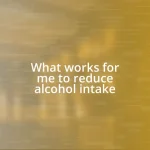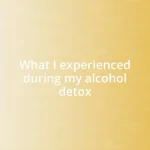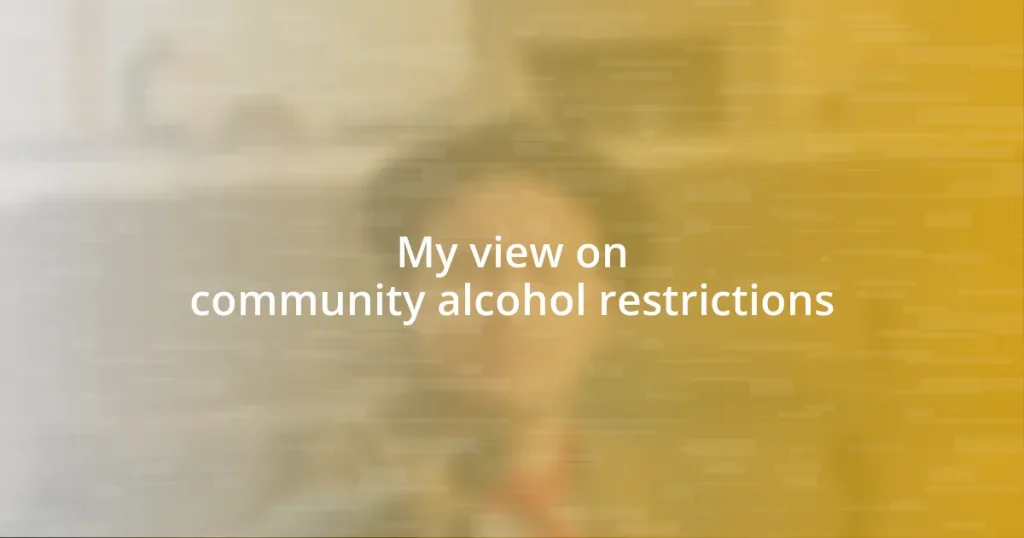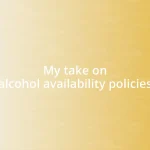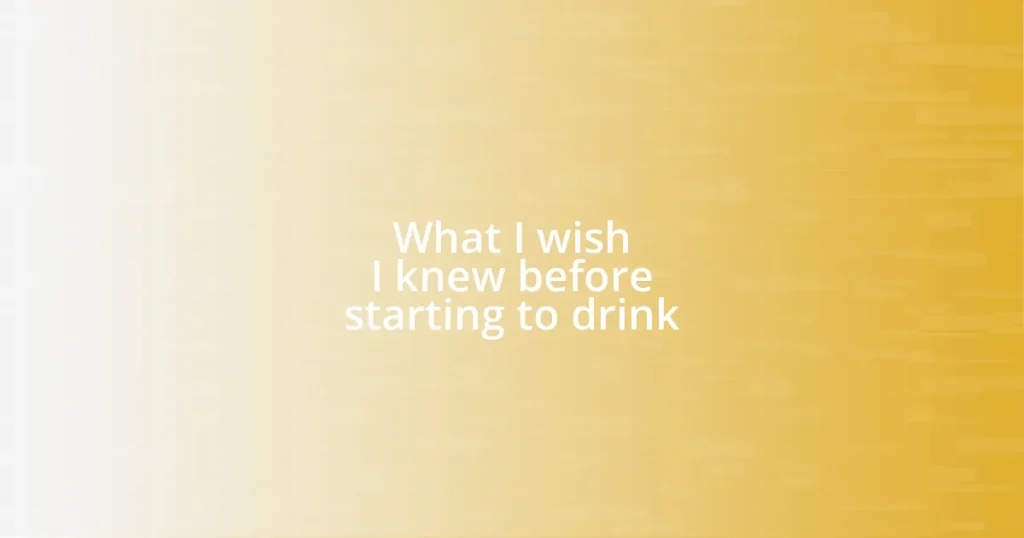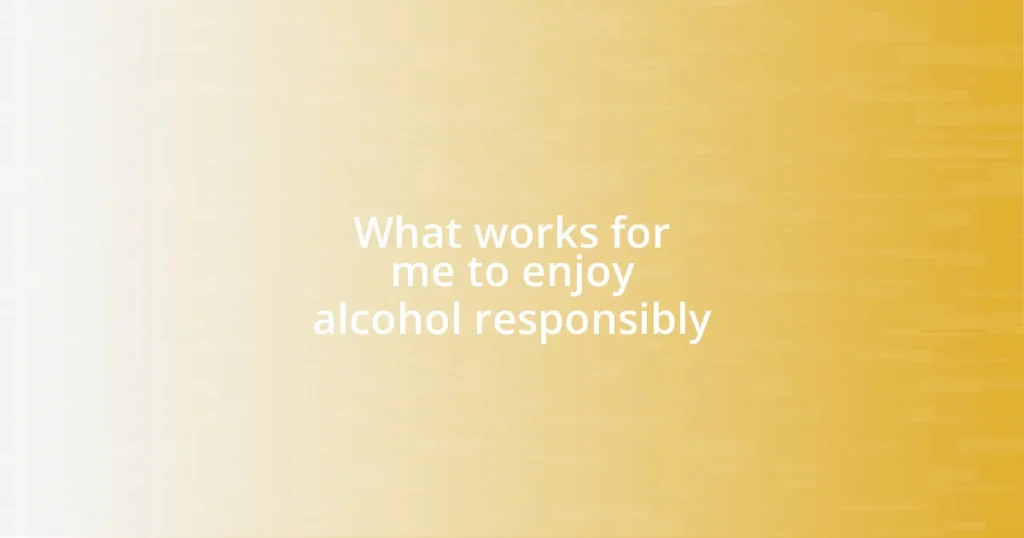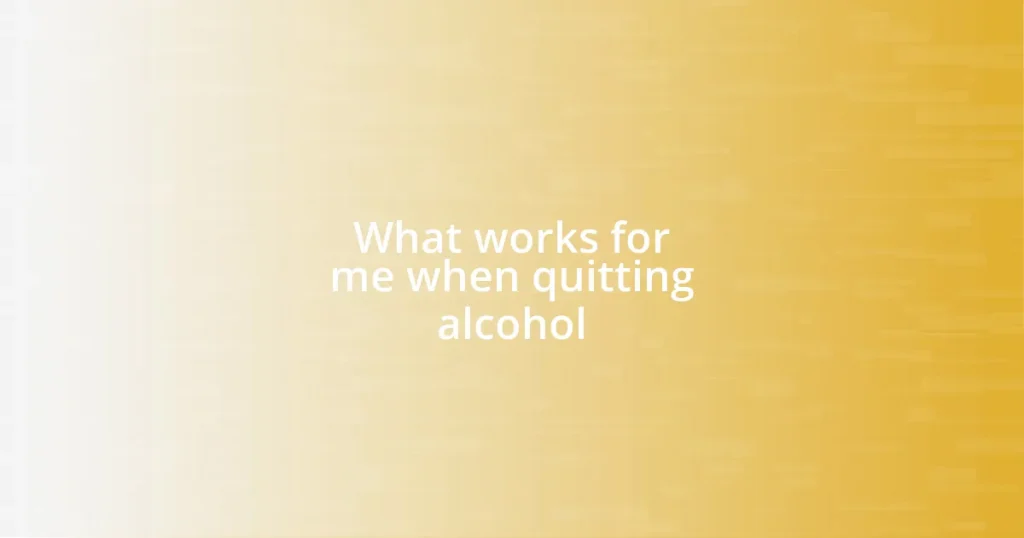Key takeaways:
- Community alcohol restrictions aim to enhance public safety and health, often reflecting local values and priorities while balancing enjoyment with safety.
- Successful restrictions can lead to increased safety, enhanced community engagement, and better public health outcomes, demonstrating that limitations may foster togetherness.
- Challenges in implementing alcohol restrictions include community resistance, economic concerns, compliance variability, and enforcement issues, requiring open dialogue and negotiation.
- Future alcohol policies may benefit from technology-driven solutions and educational strategies that promote responsible drinking and engage community feedback.

Understanding community alcohol restrictions
Community alcohol restrictions vary widely based on local laws and cultural norms, aiming to address issues like public safety and health. Have you ever found yourself at a festival or community event, only to realize that alcohol sales were curbed? It can feel a bit disheartening, but these decisions often stem from a genuine desire to create a safer atmosphere for everyone involved.
In my experience, I’ve seen towns implement temporary bans during significant events, which sparked mixed reactions. Some residents felt that it limited the enjoyment of social gatherings, while others welcomed the reductions as a way to prevent rowdiness. This brings to mind the question: How do we balance community enjoyment with safety? It’s a complex puzzle, and community input often shapes these restrictions.
I remember a neighborhood meeting where the discussion around alcohol regulations got quite heated. Some voices echoed the need for stricter rules, citing incidents that had tarnished our community’s image, while others passionately defended the idea of personal freedom. It made me realize that community alcohol restrictions are not just about policies; they reflect the values and priorities of the residents, showcasing the ongoing dialogue between safety and enjoyment.
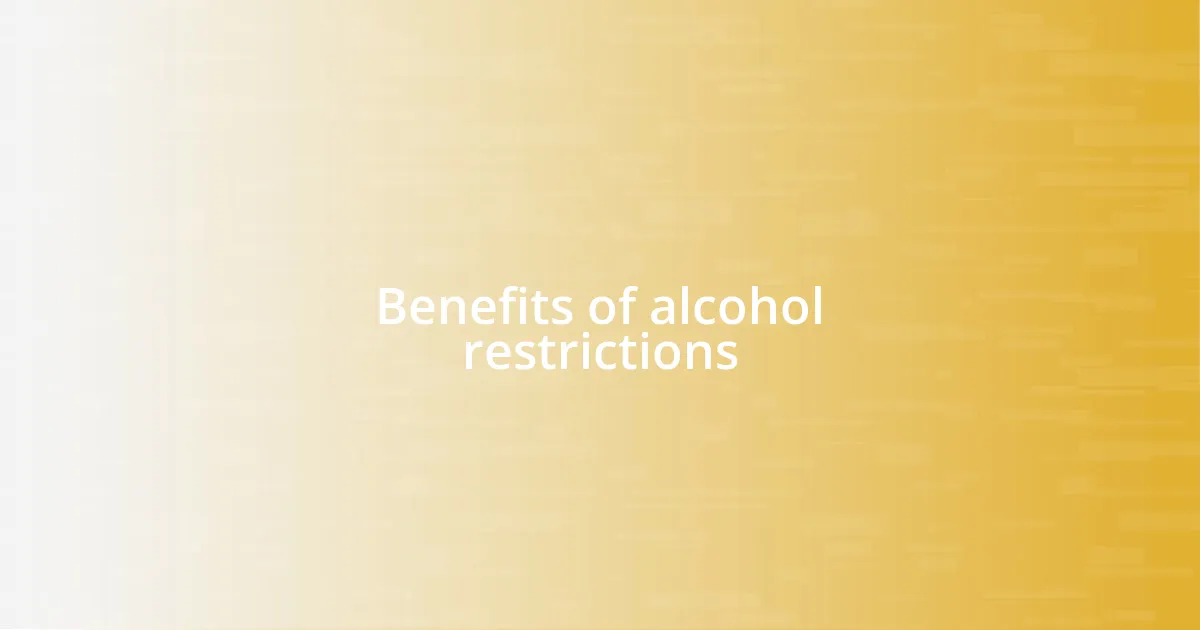
Benefits of alcohol restrictions
Alcohol restrictions, while sometimes unpopular, can significantly enhance community safety. I recall a summer festival where alcohol was limited to designated areas. There was a noticeable decrease in unruly behavior. Families felt more comfortable allowing their children to roam freely, which led to a sense of unity and enjoyment that was palpable. It highlighted how setting boundaries can actually foster greater togetherness.
In another instance, I observed a local sports event that imposed a temporary alcohol ban on game days. Surprisingly, attendees reported having just as much fun! Without the distraction of excessive drinking, fans engaged more passionately with the game and with each other. There’s something refreshing about seeing a community come alive in conversation rather than through bottles.
Furthermore, these restrictions can contribute to better public health outcomes. A friend of mine once shared how their town introduced policies limiting late-night alcohol sales. The result? A substantial decline in emergency room visits related to alcohol-related incidents. It’s fascinating to see how seemingly small regulations can lead to improved community well-being, proving that sometimes, less truly is more.
| Benefit | Impact |
|---|---|
| Increased Safety | Fewer incidents of public disorder during events |
| Enhanced Community Engagement | More meaningful interactions without the distraction of alcohol |
| Better Public Health | Reduction in alcohol-related emergencies |

Challenges of implementing restrictions
Implementing alcohol restrictions can bring about significant challenges that often go unnoticed until they’re put into practice. I remember when my local council debated introducing a ban on alcohol sales during the busy autumn festival. The discussions revealed stark divisions among residents. Some argued that it would dissuade visitors and diminish the festival’s atmosphere, while others felt it was necessary for maintaining order. This tension highlights how restrictions can trigger strong emotions and deep-seated opinions within a community, making it difficult to find common ground.
Here are specific challenges that often arise during this process:
- Community Resistance: A vocal segment may feel that their personal freedoms are being threatened, leading to pushback against any proposed restrictions.
- Economic Impact: Local businesses may worry about decreased sales, especially those that rely on alcohol sales for revenue during events.
- Variability in Compliance: Ensuring that everyone adheres to the restrictions can be difficult. Some attendees may simply bring their own alcohol to circumvent the rules.
- Enforcement Issues: Law enforcement agencies may struggle with the logistics of monitoring compliance effectively, especially in larger gatherings.
I’ve found that these challenges often require considerable negotiation and compromise, meaning that finding a solution is rarely straightforward. Each perspective must be valued, which can feel like walking a tightrope between community enjoyment and safety.

Community engagement in decision making
Engaging the community in decision-making about alcohol restrictions is crucial for fostering a sense of ownership and responsibility among residents. For instance, at a town hall meeting I attended, community members participated in brainstorming sessions that shaped the alcohol policies. It was inspiring to see people who initially disagreed come together to find common ground. How often do we get that opportunity to voice our concerns and influence local policies that affect us directly?
I’ve also noticed that when communities are actively involved, the level of acceptance for restrictions often improves. During a discussion on limiting alcohol sales after a certain hour, a neighbor shared their experience of witnessing late-night altercations. Their firsthand account helped others understand the issue from a different perspective. Isn’t it amazing how personal stories can shift viewpoints and drive home the importance of collective decision-making?
Ultimately, successful community engagement requires honest conversation and a willingness to listen. In my experience, hosting open forums can democratize the process, allowing diverse voices to emerge and ensuring that any restrictions are balanced and fair. Picture a community where everyone feels heard—doesn’t that sound like a thriving place to live? By trusting residents to take part in these discussions, we can cultivate more effective and accepted alcohol regulations that truly reflect the community’s needs.

Case studies of successful restrictions
When I think about communities that have successfully enacted alcohol restrictions, one memorable case comes to mind: a small town that reduced public alcohol consumption during its annual summer fair. Initially, many were skeptical, fearing it would dampen the festive spirit. However, after the new policy rolled out, the atmosphere transformed. Families felt safer, and attendance surged. Isn’t it fascinating how a well-implemented restriction can shift perceptions and create a more enjoyable environment for all?
Another compelling example is a neighborhood that introduced time restrictions on alcohol sales during nighttime hours. I remember chatting with a local business owner who was initially against the change, worried about lost revenue. Yet, as the policy took effect, they noticed a decrease in late-night disturbances. What intrigued me was how the owner transformed their business model, focusing more on earlier events. Isn’t it remarkable that restrictions can inspire creativity and adaptation in local economies?
In my experience, the best-case studies highlight the importance of collaboration. In one city where I volunteered, officials partnered with residents to monitor compliance through neighborhood watch programs. It strengthened community ties while promoting adherence to the new rules. With everyone involved in the process, it felt less like an imposed regulation and more like a shared responsibility. How empowering is it when communities come together to shape their environment for the better?

Evaluating the impact of restrictions
Evaluating alcohol restrictions can reveal unexpected benefits. I recall a gathering where residents discussed the introduction of a ban on alcohol sales within certain park hours. Initially, I thought it would lead to disappointment among local patrons, yet, surprisingly, families began using the parks more. They felt safer and more welcome, which made for a community vibe I hadn’t witnessed before. Isn’t it interesting how sometimes the change you fear brings about a positive transformation?
On a personal note, I watched a community deal with noise complaints from late-night parties. When a curfew on outdoor alcohol consumption was enforced, the immediate reaction was mixed. However, weeks later, people started sharing how they enjoyed the earlier nights, reigniting the joy of morning coffee gatherings. This experience taught me that restrictions can foster unexpected social benefits. Have you ever considered that rules can sometimes create space for new relationships to flourish?
Reflecting on these examples leads me to believe that the impact of restrictions often extends beyond what meets the eye. When I volunteered at a local event, I noticed an increased turnout after alcohol restrictions were implemented, as more families felt comfortable attending. The smiles on children’s faces during those gatherings filled me with joy. Isn’t it refreshing to think that sometimes, by placing limits, we can actually enhance community spirit and connection?

Future outlook on alcohol policies
Looking ahead, I’m optimistic about the evolution of alcohol policies in communities. From my perspective, there’s a growing recognition of the need to balance individual freedoms with collective well-being. In discussions I’ve had with community members, it’s clear we’re moving towards more thoughtful approaches that involve feedback from diverse voices—especially those of residents who are directly impacted. Isn’t it inspiring to think about how inclusive policy-making can lead to healthier environments for everyone?
As municipalities evaluate their alcohol policies, I foresee an increase in technology-driven solutions. For example, I recently attended a town hall where officials shared plans to implement mobile apps that help monitor compliance and gather real-time community input. It struck me how these tools could enhance transparency, making residents feel more engaged in shaping their own neighborhood regulations. Have you ever pondered how technology can transform community interactions and bring about innovative adaptations to outdated laws?
I also expect to see more education-oriented strategies alongside regulations. In my community, I’ve participated in workshops aimed at raising awareness about responsible drinking and its impacts. I found it fascinating how a little knowledge can counteract some of the fears people have about restrictions. It made me realize that when communities invest in education, they’re not just enforcing rules; they’re empowering individuals to make informed choices. Isn’t that the goal we should strive for—cultivating a culture of responsibility rather than mere compliance?



